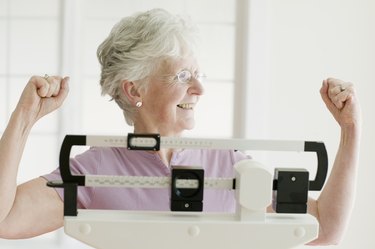
It may be rich in B vitamins, fiber and minerals, but brewer's yeast alone isn't going to melt the pounds away. That, however, doesn't mean you can't fit it into a healthy and balanced weight-loss diet. Consult a health care practitioner to discuss supplements and weight loss before making any changes to your diet.
Nutrition Facts for Brewer's Yeast
Video of the Day
Made from a single-cell fungus, brewer's yeast is not only used as a nutritional supplement but also to make beer. A 3-tablespoon serving has 95 calories, 1 gram of fat, 10 grams of carbs, 5 grams of fiber and 11 grams of protein. It also meets 25 percent or more of the daily value for thiamin, riboflavin, niacin, vitamin B-6 and pantothenic acid -- all B vitamins -- as well as the mineral phosphorus. Brewer's yeast is also a good source of the trace minerals zinc, manganese and chromium.
Video of the Day
Fiber Advantage
Adding more fiber to your diet may be an effective strategy for weight loss, according to a 2015 study published in the Annals of Internal Medicine. The researchers compared a high-fiber diet to the American Heart Association diet on weight-loss in a small group of adults with metabolic syndrome. With 5 grams of fiber per serving, brewer's yeast is an excellent source of fiber. Fiber recommendations for adults range from 25 to 30 grams a day.
Count Those Calories
While brewer's yeast has nutrients that support weight loss, it's still a source of calories. If you're trying to lose weight, you need to consider the calories from the supplement and make adjustments so that you don't eat more than your body burns. Consuming an additional 95 calories a day can cause you to gain a pound every six weeks or so, which over the course of a year may lead to an extra 10 pounds. A food journal can help you count your calories and stay on track.
Balancing Your Diet
While brewer's yeast may help boost your nutrient intake, including fiber, you need to make other changes to your diet to lose weight. FamilyDoctor.org suggests eating three meals plus one snack a day to supply a steady source of energy and help control hunger. Make fruits and vegetables the focus of your meals to save calories and get more fiber. Whole grains and beans are also good sources of fiber. Balance it out with lean sources of protein such as poultry or tofu and low-fat dairy or milk alternatives.
- University of Maryland Medical Center: Brewer's Yeast
- Lewis Labs: Brewer's Yeast Flakes
- Annals of Internal Medicine: Single-Component Versus Multicomponent Dietary Goals for the Metabolic Syndrome: A Randomized Trial
- University of California, San Francisco, Medical Center: Increasing Fiber Intake
- FamilyDoctor.org: What It Takes to Lose Weight